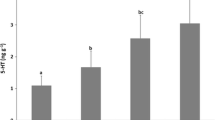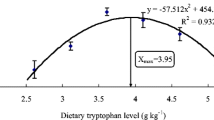Abstract
In this study, the effects of dietary tryptophan (a precursor of 5-hydroxytryptamine, 5-HT, serotonin) on the agonistic behavior, growth, and survival of freshwater crayfish were investigated. For this aim, a control diet (D1) and three experimental diets (D2, D3, and D4) were prepared. D1 contained no additional tryptophan (TRP), but D2, D3, and D4 diets were supplemented with TRP at 0.50, 0.75, and 1.00 % in dry diet, respectively. The control contained 0.33 % TRP. Results revealed that higher supplemental dietary TRP levels caused a significant decrease in the aggressive behavior (P < 0.05), but an increase in the calmness of crayfish. In addition, the results showed that 5-HT levels in the hemolymph before the fight (after 15 days of feeding; resting) were significantly different (P < 0.05) between D1 and D4. There was a significant difference (P < 0.05) in the 5-HT level of hemolymph between the crayfish fed control and D4 after 15 days of feeding. However, after the fight, 5-HT concentration was significantly higher (P < 0.05) in TRP-supplemented A. leptodactylus as compared with the control. The findings of this study showed that supplemental dietary TRP caused a significant increase (P < 0.05) in the growth and survival rate of A. leptodactylus. The crayfish fed D4 had the best survival rate at the end of the experiment (91.60 % in August). The findings of this study also showed that difference in survival rate between the crayfish fed control and D2 in June, July, and August was not significant (P > 0.05). In addition to these, supplemental dietary TRP gave rise to significantly higher specific growth rate (SGR) values in June and July (P < 0.05). For example, in June, it was 0.38 for the crayfish fed D4, 0.28 for the crayfish fed D3, 0.18 for the crayfish fed D2, and 0.13 for the crayfish fed control. However, in August, the highest SGR (0.56) was obtained from the crayfish fed control. The results also showed that the SGRs of females were lower than the males in June, July, and August (P < 0.05). In conclusion, this research shows that the aggressive behavior of A. leptodactylus can be suppressed, and rearing efficiency (i.e., increased growth and high survival rate) of this species can be improved by increasing TRP levels to 1.00 % in its diet.







Similar content being viewed by others
References
Aiken DE, Waddy SL (1992) The growth process in crayfish. Rev Aquat Sci 6(3,4):335–381
Akiyama DM, Dominy WG, Lawrence AL, (1991) Penaeid shrimp nutrition for the commercial feed industry revised. In: Akiyama, DM, Tan RKH (Eds.) Proceedings of the aquaculture feed processing and nutrition workshop, Thailand and Indonesia Sept. 19–25. American Soybean Association, Singapore, pp. 80–98
American Public Healt Association (APHA) (1985) Standart methods for the examination of water and wastewater, 16th. edn. 1268 pp. Washington
AOAC (1997) Official methods of analysis of association of official analytical chemists, 16th edn. AOAC, Arlington, p 1298
Claudia CO, Miguel RS, Angela ONM, Yurrita PJG (2004) Effect of density and sex ratio on gonad development and spawning in the crayfish P. llamasi. Aquaculture 236:331–339
Grovest RE, (1985) The crayfish: ıts nature and nurture fishing new boks Ltd. England, pp:72
Harlıoğlu MM (2004) The present situation of freshwater crayfish, Astacus leptodactylus (Eschscholtz, 1823) in Turkey. Aquaculture 230:181–187
Harlıoğlu MM (2008) The harvest of the freshwater crayfish Astacus leptodactylus Eschscholtz in Turkey: harvest history, impact of crayfish plague, and present distribution of harvested populations, Aquacult. Int 16:351–360
Harlıoğlu MM (2009) A comparison of the growth and survival of two freshwater crayfish species, Astacus leptodactylus Eschscholtz and Pacifastacus leniusculus (Dana) under different temperature and density regimes. Aquacult Int 17:31–43
Harlıoğlu AG (2011a) Present status of fisheries in Turkey. Rev Fish Biol Fisheries 21:667–680
Harlıoğlu, A.G., 2011b. Problems and solutions in the aquaculture sector in Turkey, World Aquaculture, 42(4):15–16, 69–71
Harlıoğlu MM, Köprücü K, Harlıoğlu AG, Yılmaz Ö, Aydın S, Mişe Yonar S, Çakmak Duran T, Özcan S (2012) The effects of dietary n-3 series fatty acid on the fatty acid composition, cholesterol and fat-soluble vitamins of pleopadal eggs and stage 1 juveniles in a freshwater crayfish, Astacus leptodactylus (Eschscholtz). Aquaculture 356–357:310–316
Hoglund E, Bakke MJ, Øverli Ø, Winberg S, Nilsson GE (2005) Suppression of aggressive behaviour in juvenile Atlantic cod (Gadus morhua) by l-tryptophan supplementation. Aquaculture 249:525–531
Hseu J.R., Lu F.I., Su H.M., Wang L.S., Tsai C.L., Hwang P.P., 2003. Effect of exogenous tryptophan on cannibalism, survival and growth in juvenile grouper, Epinephelus coioides. Aquaculture, 1–12
Huber R, Delago A (1998) Serotonin alters decisions to withdraw in fighting crayfish, Astacus astacus: the motivational concept revisited. J Comp Physiol 182A:573–583
Hubert, R., Smith, K., Delago, A., Isaksson, K., Kravitz, E., 1997. Serotonin and Aggressiveness Motivation in Crustaceans: Altering the Decision to Retreat. Proceedings of the National Academy of Science USA 5939–5942
Jover M, Carmona JF, Del Rıo MC, Solee M (1999) Effect of feeding cooked-extruded diets, containing different levels of protein, lipid and carbohydrate on gowth of red swamp crayfish (P. clarkii). Aquaculture 178:127–137
Kokko H, Koistinen L, Harlioğlu MM, Makkonen J, Aydın H, Jussila J (2012) Recovering Turkish narrow clawed crayfish (Astacus leptodactylus) populations carry Aphanomyces astaci. Knowl Managt Aquatic Ecosyst 404:12
Köksal G (1988) Astacus leptodactylus in Europe. In: Holdich DM, Lowery RS (eds) Freshwater Crayfish: Biology. Croom Helm, London and Timber Press, Oregon, Management and Exploitation, pp 365–400
Laranja JLQ, Quinitio ET, Catacutan Mae R, Relicardo MC (2010) Effects of dietary l-tryptophan on the agonistic behavior, growth and survival of juvenile mud crab Scylla serrata. Aquaculture 310(1–2):84–90
Lowery, R.S., 1988. Growth, moulting and reproduction, In: : Holdich D.M., Lowery R.S. (Eds.), Freshwater Crayfish: Biology, Management and Exploitation, Croom Helm. London and Timber Press, Oregon, pp: 83–114
Maler L, Ellis WG (1987) Inter-male aggressive signals in weakly electric fish are modulated by monoamines. Behav Brain Res 25:75–81
Millamena OM, Teruel MB, Kanazawa A, Teshima S (1999) Quantitative dietary requirements of postlarval tiger shrimp, Penaeus monodon, for histidine, isoleucine, leucine, phenylalanine and tryptophan. Aquaculture 179:169–179
Moore PA, Bergman DA (2005) The smell of success and failure: the role of intrinsic and extrinsic chemical signals on the social behavior of crayfish. Integr Comp Biol 45:650–657
Munro AD (1986) Effects of melatonin, serotonin, and naloxone on aggression in isolated cichlid fish (Aequiidens pulcher). J Pineal Res 3:257–262
National Research Council (NRC) (1987) Predicting feed intake of food-producing animals subcommittee on feed ıntake committee on animal nutrition board on agriculture. National Academy Press, Washington, D.C
National Research Council (NRC), 1993. Nutrient Requirements of Fish. National Research Council (NRC), Washington, D.C. National Academy Press. 114 p
Panksepp JB, Yue Z, Drerup C, Huber R (2003) Amine neurochemistry and aggression in crayfish. Microsc Res Tech 60:360–368
Peeke HVS, Blank GS, Figler MH, Chang ES (2000) Effects of exogenous serotonin on a motor behavior and shelter competition in juvenile lobster (Homarus americanus). J Comp Physiol A 186:575–582
Perez JR, Carral JM, Celada M, Saez-Royuela M, Sierra A (1997) Current status of astaciculture production and commercial situation of crayfish in Europe. Aquacult Europe 22(1):6–13
Reynolds, J.R., 2002. Growth and reproduction, In: Holdich D.M. (Ed.) Biology of Freshwater Crayfish. Lowa State University Press
Svoboda J, Kozubíková E, Kozák P, Kouba A, Bahadir Koca S, Diler Ö, Diler I, Policar T, Petrusek A (2012) PCR detection of the crayfish plague pathogen in narrow-clawed crayfish inhabiting Lake Eğirdir in Turkey. Dis Aquat Organ 98:255–259
Taugbøl T, Skurdal J (1992) Growth, mortality and molting rate of noble crayfish, Astacus astacus L., juveniles in aquaculture experiments. Aquacult Fisher Manage 23:411–420
Tierney AJ, Mangiamele LA (2001) Effects of serotonin and serotonin analogs on posture and agonistic behavior in crayfish. J Comp Physiol A 187:757–767
Tierney AJ, Greenlaw MA, Dams-O’Connor K, Aig SD, Perna AM (2004) Behavioral effects of serotonin and serotonin agonists in two crayfish species, Procambarus clarkii and Orconectes rusticus. Comp Biochem Physiol A 139:495–502
Vergara MPH, Rouse DB, Novoa MAO, Davis DA (2003) Effects of dietary lipid level and source on gowth and proximate composition of juvenile redclaw (C. quadricarinatus) reared under semi-intensive culture conditions. Aquaculture 223:107–115
Wickins, J.F., Lee, D.O’C., 2002. Crustacean Farming, Ranching and Culture. Blackwell Science, pp: 446
Winberg S, Øverli Ø, Lepage O (2001) Suppression of aggression in rainbow trout (Oncorhynchus mykiss) by dietary l-tryptophan. J Exp Biol 204(22):3867–3876
Acknowledgments
This study was carried out as a part of a research Project, “An investigation on the effects of dietary l-tryptophan on the agonistic behavior, growth, and survival of freshwater crayfish Astacus leptodactylus Eschscholtz” supported by the Scientific and Technological Research Council of TURKEY (TÜBITAK-TOVAG, Project No: 111O418).
Author information
Authors and Affiliations
Corresponding author
Rights and permissions
About this article
Cite this article
Harlıoğlu, M.M., Harlıoğlu, A.G., Mişe Yonar, S. et al. Effects of dietary l-tryptophan on the agonistic behavior, growth, and survival of freshwater crayfish Astacus leptodactylus Eschscholtz. Aquacult Int 22, 733–748 (2014). https://doi.org/10.1007/s10499-013-9702-1
Received:
Accepted:
Published:
Issue Date:
DOI: https://doi.org/10.1007/s10499-013-9702-1




